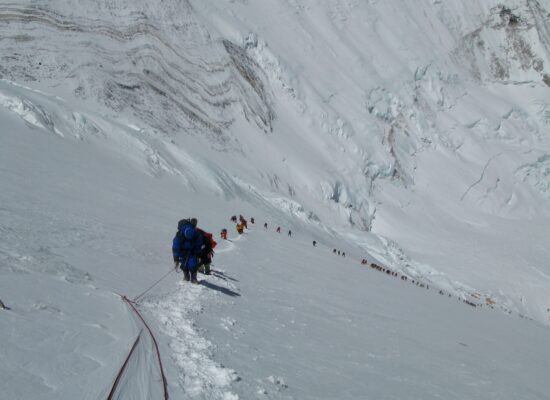Leif Whittaker is walking in large footsteps. You see, sick his father, Jim Whittaker, was the first American to summit Everest. He and the nephew of Tenzing Norgay, Sherpa Nawang Gombu, summited on May 1, 1963. They ran out of oxygen but managed to reach the summit. Now Leif is on his Everest climb with the RMI team lead by Dave Hahn.
The Whittaker family define American mountaineering. Lou Whittaker, Jim’s brother, led the first American expedition from the north side and started the guide service Rainer Mountaineering Inc (RMI) that secured an exclusive guiding permit for Mt. Rainier. Decades later, they have led over 100,000 climbers to the summit. Interesting, Jim was employee #1 for REI and later their CEO.
So today, Leif is following the footsteps of legends. He has trained hard with climbs on Vinson and Aconcagua this year. He writes eloquently in his blog. It is easily the Blog of the Day.
47 years ago my father, Jim Whittaker, and the American Mount Everest Expedition had already been hiking for 15-days before they stomped through the same village. Back then, there was no knucklebiting flight. Instead, there was a meandering and dusty trail that began on the rough and tumble outskirts of Kathmandu. Their team—comprised of 19 mountaineers and over 900 porters—gradually climbed into this beautiful valley, this magnificent setting in which my team and I have now been deposited.
Leif follows in other steps as well. Brent Bishop, son of Barry Bishop, summited in both 1994 and 2002. Bret’s father was the first American to climb Ama Dablam. He was on the first American team to summit Everest with Jim Whittaker in 1963.
Sir Edmund Hillary’s son, Peter Hillary, summited in 1990. of course, his father and Tenzing Norgay made the first summit Everest in 1953. Peter has been to Everest five times.
You can follow Leif on his blog, the RMI site and the First Ascent site.
The 2010 season continues like clockwork with teams in Nepal and Tibet moving towards their base camps.
The north teams are spending a day or two in Tibetan villages for acclimatization purposes. These villages, like Tingri at 14420′, are driven to and through. They are significantly higher than on the Nepal side; so a few days stop at strategic altitudes will help the climbers arrive BC in better shape. These are so called active rest days where climbers will trek up local hills to stress their systems a bit as repoted by Geordie Stewart in his blog:
We have now reached Nyalam which is at about 3750m – a bit of a gain from where we were so there are a few headaches floating about amongst the team but nothing serious. Today was fun as we went for a bit of a wander to 4000m or so which was a good way to get the red blood cells produced and to get the legs moving after so much travelling. The next few days will take a similar pattern, “climb high, sleep low” is the acclimatisation pattern and should stand us in good stead for when we reach Base Camp (5000+ m) in a few days time.
In Nepal, teams are now in the highest villages and only a day or two away from base camp. Villages such as Gorak Shep are seasonal during the summer months when they were historically used to graze yaks on the grassy slopes. Today, Sherpas run teahouses for trekkers and climbers during the summer months.
One final highlight of the trek in, is a quick visit to the summit of Kala Patar at 18,192′. Even if they have been there before, most climbers still make the climb to look directly down on BC, Ama Dablam to the south and, of course, Everest herself. It is simply the in the Khumbu!
Many guides have already visited EBC as well as some climbers. As previously noted, Sherpas have been there for weeks reserving and setting up camps and getting everything ready for the team’s arrival. They truly are the hard workers behind the scenes.
The Icefall Doctors now have the route all the way to Camp 1 – incredibly early. There are reports of a low snow year and little avalanche danger from the West Shoulder unlike last year. But climbers will always be aware of changing conditions.
So, after years, months, weeks, days and hours of hard work, planning and training; climbers are about to reach their home for the next six weeks – to climb to the top of the world!
Climb on!
Alan




One thought on “Leif Whittaker: Following His Father’s Footsteps”
I like the way he describes the Lukla flight.
Comments are closed.